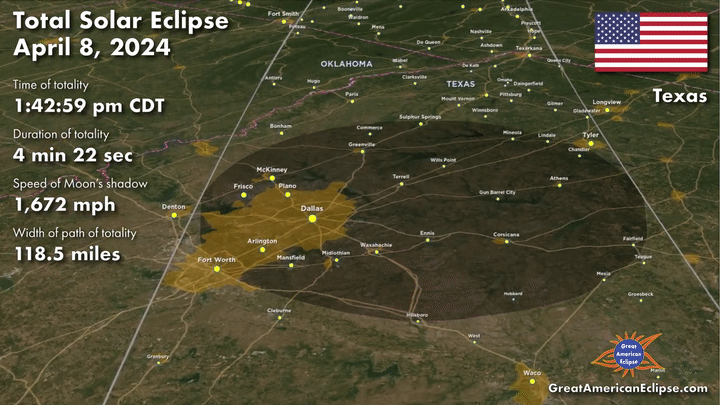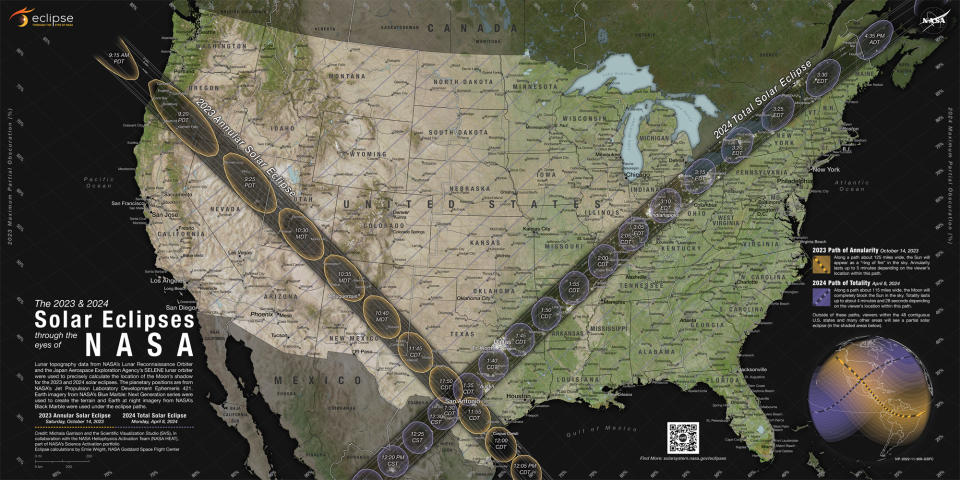Watch the moon's shadow travel across North America during 2024's total solar eclipse (video)

A total solar eclipse will be visible across North America on April 8, 2024.
Dubbed "The Great North American Eclipse", the event will be apparent throughout North and Central America. The solar eclipse will start in Mexico, cross into Texas then head northeast into the Ohio River Valley, through upstate New York, Quebec, Canada and New England, finally exiting the continent through the Canadian Maritimes.
To see the solar eclipse in all its glory, that is with the moon's shadow completely blocking the sun, you need to be located within the path of totality.
This animation, created by expert solar eclipse cartographer Michael Zeiler at GreatAmericanEclipse.com illustrates the location and width of the path of totality, starting at 123 miles wide at Sinaloa, on the Pacific coast of Mexico and narrowing to 100 miles wide in Newfoundland and Labrador, Canada. The speed of the moon's shadow also drastically increases as it sweeps across Earth's surface from 1,500 mph (2,414 km/h) to over 5,000 mph (8,046 km/h).
Related: This epic NASA map shows where to see US solar eclipses in 2023 and 2024 (photos)
What is a solar eclipse?
A solar eclipse occurs when the moon is positioned between Earth and the sun and casts a shadow over Earth, when the sun is fully obscured by the moon's shadow it is known as a total solar eclipse.
The maximum duration of totality will last as long as 4 minutes and 26 seconds while the moon's shadow is over southwest Texas). That's 135 seconds longer than the US average and 40 percent longer than the maximum duration of the 2017 eclipse.
"To make your duration of totality longer, travel to the center of the path of totality closest to you. " Zeiler told Space.com in an email. "You’ll never regret the travel to see totality, nature’s greatest sight".
"If you see a curve on an eclipse map that says 99%, don’t think that means a total eclipse. 99% partial eclipse = 0% total eclipse! The difference between being inside and outside the path of totality is absolutely night and day." Zeiler continued.
How the solar eclipse video was made
Related stories:
— How to photograph a solar eclipse
— Lunar eclipses: When, where & how to see them
— Solar eclipse from space! Watch the moon's shadow sweep across Earth in satellite footage (video)
Many weeks and multiple data sets were required to create the impressive flyover animation.
Zeiler began with lunar terrain data derived from the Lunar Reconnaissance Orbiter to apply corrections to the moon's shadow and accurately predict the timings of totality.
He then rendered the moon's shadow, frame-by-frame, on the topography of the area.
"In the mountainous parts of the path in Mexico, you’ll see how the shadow edge responds to mountain elevations," Zeiler said.
The animation was built upon earlier datasets that Zeiler had created for his "Atlas of Solar Eclipses 2020 to 2045". As he had computed a set of moon shadow shapes on Earth for every second of the 2024 solar eclipse crossing North America.
"The last work in creating the animation took about 3 weeks."
During that time Zeiler simulated the arc of an imaginary spacecraft following the moon's shadow.
Upcoming solar eclipses

Before the total solar eclipse in 2024, many skywatchers will be treated to an annular "ring of fire" solar eclipse on Oct. 14, 2023. The annular eclipse will begin in the U.S. and travel from the coast of Oregon to the Texas Gulf coast, passing over Nevada, Utah, New Mexico as well as some parts of California, Idaho, Colorado and Arizona, according to NASA. It will then continue on to Central America, passing over Mexico, Belize, Honduras and Panama. South America will also experience the annular eclipse as it passes over Colombia before ending off the coast of Natal, Brazil.
During both the annular solar eclipse of 2023 and the total eclipse of 2024, all 48 contiguous states of the U.S. — the lower 48 states on the North American continent — will see at least a partial eclipse whereby part of the sun is obscured by the moon's shadow.
If you plan on viewing a solar eclipse, remember: NEVER look at the sun with binoculars, a telescope or your unaided eye without special protection. Astrophotographers and astronomers use special filters to safely observe the sun during solar eclipses or other sun phenomena. Here's our guide on how to observe the sun safely.

